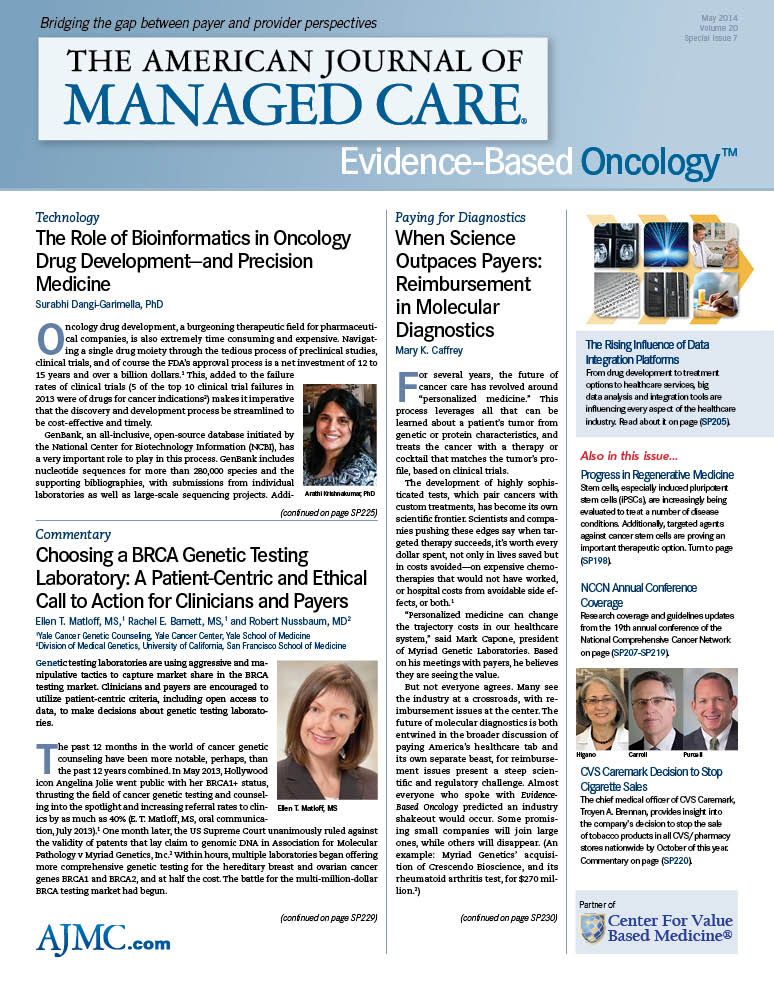- Center on Health Equity & Access
- Clinical
- Health Care Cost
- Health Care Delivery
- Insurance
- Policy
- Technology
- Value-Based Care
Denlinger Discusses Posttreatment Surveillance for Cancer Survivors
NCCN Guidelines Updates
Crystal Denlinger, MD, keeps expanding her expertise in “survivorship.” The Fox Chase Cancer Center physician almost didn’t make it to the National Comprehensive Cancer Network’s 19th Annual Conference in Hollywood, Florida, after her evening flight from Philadelphia to Fort Lauderdale, Florida, crashed on the runway just after takeoff on March 13, 2014.1
Undaunted, Denlinger boarded a later flight and arrived in Florida after midnight, on March 14, 2014, in time to rest before her presentation with Terry S. Langbaum, MAS, of Johns Hopkins. The pair discussed what patients and providers should know about surveillance after the initial wave of cancer care ends.
Langbaum, a cancer center administrator who has had Hodgkin’s disease, and Denlinger, a medical oncologist and specialist in gastric cancer, opened the discussion by laying out a common misconception: patients who have survived cancer assume that good follow-up care means lots of tests and scans. But, as Denlinger showed, the evidence says that isn’t so.
Her presentation, “Optimal Post-Treatment Surveillance: Is More Really Better?” addressed a topic that challenges not only patients and their physicians, but also payers and accountable care organizations (ACOs) as we move toward a national healthcare system, searching for better quality at a lower cost. First, Denlinger opened her “less is more” argument with a few realities: most recurrences are picked up by symptoms, not scans or exams; the risk of recurrence is greatest within the first 5 years of diagnosis; and a cure with treatment after a recurrence is unlikely in most cancers, although palliative care can extend life and bring better quality.
While there are arguments in favor of active surveillance with multiple tests, there are also downsides, especially as cancer patients live longer, Denlinger said. Exposures to too much radiation and procedures carry their own risks, burden patients with added costs and anxiety, and can get in the way of more productive elements of survivorship care, such as making positive lifestyle changes. Concerns about the cumulative effect of too much imaging were borne out in a 2009 study. Over 22 years, a cohort of 31,462 US patients were studied, and it was determined that repeated computed tomography (CT) exposure adds to baseline cancer risk; while most patients accrued low radiation-induced cancer risks, a small subgroup of 7% had higher risks due to the cumulative effects of repeat CT imaging.2
“A CT scan is not as benign as one might have thought,” Denlinger said. “The evidence shows there is a subset facing a cancer risk just from the radiation (of the tests).” What’s more, CMS is starting to limit the number of lifetime scans a person may have to reduce these dangers, she said.
If testing occurs, it should be meaningful. Denlinger offered some parameters:
• The interval between tests, and the duration of testing, should align with the maximal recurrence risk and tumor history.
• Testing should be directed at the sites where recurrence is most likely.
• Testing should have high predictive value.
• Don’t test except if there is a therapy available for a cure, to prolong life, or to provide relief of symptoms.
• Test if there is an increased risk of a secondary malignancy, based on shared risk, but do so knowing the complications of therapy.
Denlinger then went through a variety of studies and scenarios across breast, colorectal (CRC), lung, gastric, prostate, and ovarian cancers, indicating where surveillance would be most beneficial. It turns out that of the major cancers, recent evidence shows CRC survivors benefit the most from regular carcinoembryonic antigen testing, with CT at 12- to 18-month intervals.3
Surveillance after lung cancer is controversial and the subject of mixed results, Denlinger said, in part because 50% of cancer recurrence for these patients occurs outside the lung. The USPSTF last year called for lung cancer screenings for older smokers and former smokers meeting certain criteria before cancer hits. Denlinger said the most important “survivorship” issue for lung cancer patients who are smokers is to make sure they quit.
EBO
Denlinger acknowledged that the “less is more” approach will require some adjustments, but it’s essential. “Survivors are living longer. Many, many survivors are living past that 5-year mark. We are potentially doing them harm. It’s going to take some mind-set changing,” she said.
At the 19th Annual Conference of the National Comprehensive Cancer Network (NCCN), held March 12-15, 2014, experts reviewed research and presented updates to the NCCN Clinical Practice Guidelines in Oncology. The conference also featured a roundtable discussion on how the early months of implementing the Affordable Care Act are affecting the delivery of cancer care. Beyond treatment for cancer, NCCN issued updates to last year’s survivorship guidelines as well as new recommendations in the realm of cancer screening.
For complete NCCN guidelines, create a profile and visit: http://www.nccn.org/professionals/default.aspx.
For the August 2013 NCCN Bone Health Task Force Report, visit: http://www.nccn.org/JNCCN/supplements/PDF/bone_health_cancer_care_tf.pdf.
References
1. Mulcahy N. Oncologist survives plane crash, gives NCCN talk. Medscape Multispecialty. March 14, 2014. http://www.medscape.com/viewarticle/822040.
2. Sodickson A, Baeyans PF, Andriole KP, et al. Recurrent CT, cumulative radiation exposure, and associated radiation-induced cancer risks from CT of adults. Radiology. 2009;251:175-184.
3. Primrose JN, Perera R, Gray A, et al. Effect of 3 to 5 years of scheduled CEA and CT follow-up to detect recurrence of colorectal cancer: the FACS randomized clinical trial. JAMA. 2014;311(3):263-270.

Blister Packs May Help Solve Medication Adherence Challenges and Lower Health Care Costs
June 10th 2025Julia Lucaci, PharmD, MS, of Becton, Dickinson and Company, discusses the benefits of blister packaging for chronic medications, advocating for payer incentives to boost medication adherence and improve health outcomes.
Listen

